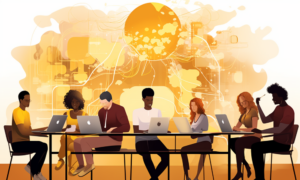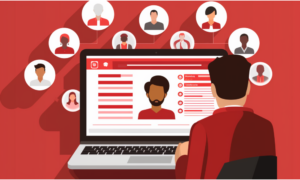Technology in HR - how far have we come?
- 6 Min Read
Technology and learning go hand in hand when businesses look to engage and develop their workforce. Martin Blackburn, People Director, KPMG, he discusses the positive developments being made in HR Technology.
- Author: Martin Blackburn
- Date published: Jun 3, 2019
- Categories

“Technology continues to revolutionise so many areas of HR that it’s sometimes difficult to appreciate how far we’ve come.”
More years ago than I care to mention, I remember I was due to present at a graduate recruitment milkround event. Gosh, even that terminology sounds outdated. But anyway, this was to be my first major presentation in front of an audience so I thought I’d better learn how to present. Properly.
This was back in the early 90’s when I worked for another big 4 firm. I duly flicked through the learning curriculum which was printed in this big glossy book. I found Presentation Skills (Beginners), completed the form, discussed my learning needs with my line manager, got her approval and waited to find out if I’d been booked onto the residential programme. I remember rather optimistically selecting the week long course that was running in Manchester around Christmas as I had friends from Uni there. A couple of weeks later, I found out I had indeed been booked on the next course. 3 months away. In Elephant & Castle. Bring your own sandwiches.
Fast forward 25 years and last week I had another big presentation. I felt I could do with a quick refresher of skills. So I logged onto KPMG’s internal video sharing platform – KPMG Player. It’s like our own version of YouTube but without videos of cats playing the piano. Type in ‘presentation skills’ and I get short videos of top tips that anyone can upload. ‘Touch Turn Talk’ – touch the flipchart where you want the audience to look, turn to them and then talk. ‘How to Stand when Presenting’. Turns out I’ve been doing that wrong for 25 years by adopting a T Rex position. ‘Do the Penguin’. Not entirely sure what that one was about. But rather like video production, learning has been democratised. Anyone in KPMG can upload a video onto the platform. So we get real-time learning that is easily shared and searched in bite-size segments.
Does the residential – or classroom programme still have a part to play? Yes. Particularly where the presence of a skilled learning professional is crucial to the success of the learning or the approach needs to be tailored to each individual on the course, or when the aim of the programme is to foster a culture of collaborative working or support team building, as well as deliver learning needs.
But the crucial thing is I now have a choice. I might instead opt for the virtual classroom – a learning environment in which participants can interact, communicate, view and discuss content, and engage with learning resources while working in groups. The virtual classroom can be achieved with very simple technology such as a WebEx or Skype call if limited interaction is required, or for more complex learning topics Adobe Virtual Classroom allows users to virtually raise their hands, enter in real-time polls or use a whiteboard for group discussions.
If time is of the essence, I can go for those instant video-based tips from anyone in the firm. Or I can access the firm’s e-learning portal for more detailed programmes. And the choice doesn’t end there. Like a Scandi noir box set, I can binge on the entire programme or take it in episodic chunks. The big thing is that I own my own learning. And if there’s one thing we know about millennials and post-millennials coming into the workforce, it’s that they increasingly expect to own their own experience. They want to choose which learning they undertake with a particular focus upon their own marketability and brand. As the traditional breakdown between work and home time blurs, they want to choose when.
We are seeing similar revolutions in performance management. We are so used to traditional PM systems that have feedback at defined periods of the year with a ‘year-end assessment’. This concept is anathema to a millennial. This is a population used to continuous feedback. And that quest for feedback can be addictive. Positive affirmations from social media release dopamine into the brain, dopamine being a highly addictive substance. Take those same bright feedback-hungry individuals and tell them they have to wait up to a year for their feedback assessment and it’s not surprising they struggle with that concept.
The same is true of learning. Waiting for a year-end performance assessment from which the learning needs emerging and courses are booked just doesn’t make sense to a population that is used to instant gratification of their needs. Further, given the workforce of the future is likely to be more contingent with shorter career horizons, is it incumbent upon firms to enable people to ‘plug and play’ – come into KPMG for whatever period and enhance their skills and brand from day one.
What organisation doesn’t say people are its most important asset? Well, if that’s truly the case, just as we want technology with the latest releases, we similarly want people with the most up to date skills. That means continuous development with our people having access to learning opportunities when they need it in whatever format they need it.
And what about the more traditional thinking that learning should be created purely by ‘learning experts’? We’ve seen a shift in recent years as the importance of on the job learning and coaching has increased. Transporting that actual experiential learning back into the workforce where everyone is a learning expert allows an organisation to have a workforce that’s basically a team of player coaches, and learning is real-time, and constant. In this world, the role of the learning professional becomes one of curating learning experiences as opposed to owning and developing all of them.
And finally, that glossy learning curriculum I once flicked through? Well, technology has changed the Learning Management System as well. Increasingly they now use machine learning to craft a tailored platform of suggested learning interventions for each user. These products encourage a continuous learning culture by providing content from a range of sources including video platforms, relevant articles and formalised virtual classrooms as well as the ability for users to upload and share their own content.
So all in all the world of learning is in many ways hardly recognisable from the learning we experienced a decade or two ago. But what remains constant is the need to ensure people have access to the skills they need when they need them. That after all is the heart of any employment deal.








